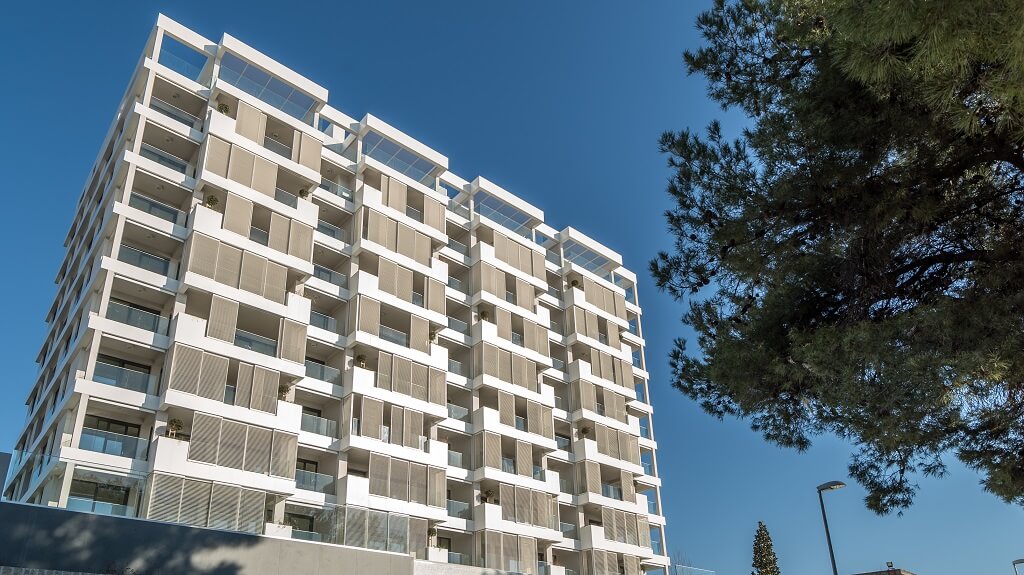MIAMI—The architecture of innovation and disruption—and an unflinching view of the challenges and opportunities for architecture and design by and for disruptors. That was the foundation of a fascinating discussion between keynote speaker Gregg Pasquarelli of SHoP Architects, Fast Company’s “Most Innovative Architecture Firm in the World,” and David Martin, president of Terra, who has engaged some of the world’s leading architects in distinctive South Florida projects, at the sixth annual University of Miami Real Estate Impact Conference.
Founded in 1996 years ago by professionals who pursued architecture as a second career, SHoP Architects is on a mission to harness the power of diverse expertise in the design of buildings and environments that improve the quality of public life. The firm employs an interdisciplinary staff of 180 and has consistently introduced disruptive thinking that is impacting the real estate industry.

Modera Metro Dadeland is an innovative architectural design.
“It was a different time in architecture” Pasquarelli said. “There were strong divisions, with paper architects and service architects that could make a building that didn’t leak. We wanted to understand how to make more beautiful buildings more cost effectively. We invested in understanding and finding technology, politics, sustainability, branding and marketing disciplines and bringing them all in house to form an architectural think tank.”
It worked. SHoP is known for its work with the Howard Hughes Corporation to develop South Street Seaport, its collaboration with JDS Development on 111 West 57th, and more recently the American Copper Building and 9 Dekalkb Avenue. The firm has completed 10 buildings, but since expanding to target more public sector clients reports 22 buildings under construction and another 40 in the pipeline.
“Real estate tends to do things the same way until one person innovates and then you all instantly change,” Pasquarelli told Martin. “We’ve found that every time we’ve been able to use technology to improve cost control or transparency or manufacturing costs in one of our buildings and we have hard data showing it works, everyone jumps on board.”
As one prime example, Pasquarelli pointed to Barclays Center, a landmark sports and entertainment arena in Brooklyn. The arena’s shape dons three bands and features a glass curtain wall donning lattice work made from 12,000 pre-weathered steal panels that give it a brownstone feel. SHoP relied heavily on unproven, cutting-edge technology to make it happen.
“In order to make that façade, we started investing in tech in the mid-90s,” Pasquarelli said. “We worked with CNC technologies. We couldn’t get any of our clients to take a chance for us to let the computer make a façade of the building. We had to test out these ideas on our own building.”
SHoP has also successfully undertaken reconversion projects in New York, including Two Trees Management’s Domino Sugar Factory project in Williamburg. The project transformed the factor into an office building. The overarching project, which makes adaptive reuse of the 380,000-square-foot building, will also see 2,800 multifamily units rise.
“We thought there was a deeply flawed plan and should be rezoned,” Pasquarelli said. “First thing you need to do is bring a street through the front. You need to make the park feel public and that does not detract from your real estate value at all. It was about knitting the neighborhood back into the existing context. We increased public space by about 40% and increased the height of the building by 5%. Taller and thinner buildings with holes in them that allowed more light into neighborhoods behind.”
SHoP is also a big proponent of wellness concepts in office buildings and mixed-income housing. Pasquarelli pointed to the Genzyme building in Cambridge, the first LEED platinum building with 15 years of hard data, as proof of the benefits. Genzyme assessed employee sick days at various buildings it owns. The workers had the same blend of education and income levels but the wellness-oriented building saw fewer sick days among workers.
“Almost every project in New York is mixed income,” Pasquarelli said. “The most fascinating data that’s come out of this is the warehousing of the poor really drive prime rates. What studies have found is distributing income levels it drives prime rates down. The Porter House, in the meat packing district, was a project with rough crime statistics and now West Chelsea is one of the greatest art centers in the world. Crime rates have dropped. There’s a lot of social benefit to mixed-income projects.”


